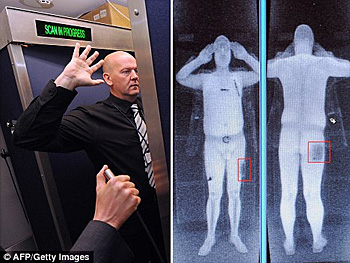
|  |  |  Travel & Outdoors Travel & Outdoors  
Airport X-Ray Scanner is Just as Likely to Kill You as a Terrorist Bomb
 Daily Mail UK Daily Mail UK
go to original
November 20, 2010


| | No worries: A US scientist has claimed that the risk of getting cancer from a single airport body scanner is about 1 in 30 million. |  |
Full-body airport scanners are just as likely to kill you as a terrorist's bomb blowing your plane out of the sky, a leading scientist has said.

The controversial machines have been brought in at major airports across the globe, including the UK, leading to fears that the increased exposure to harmful radiation may cause cancer.

Now a US physics professor has added to the debate by claiming that the scanners are redundant because you are just as likely to contract cancer from the radiation as you are to die in a terrorist bomb on your flight.

Peter Rez, from Arizona State University, said the probability of dying from radiation from a body scanner and that of being killed in a terror attack are both about one in 30 million.

He said: 'The thing that worries me the most, is not what happens if the machine works as advertised, but what happens if it doesn't.

A potential malfunction could increase the radiation dose, he said.

Rez has studied the radiation doses of backscatter scanners using the images produced by the machines. He discovered that the radiation dose was often higher than the manufacturers claimed.

Rez suggested that the statistical coincidence means that there is really no case to be made for deploying any kind of body-scanning machine - the risk is identical.

But he added: 'They're both incredibly unlikely events. These are still a factor of 10 lower than the probability of dying in any one year from being struck by lightning in the United States.'

Critics say the low level beam used delivers a small dose of radiation to the body but because the beam concentrates on the skin - one of the most radiation-sensitive organs of the human body - that dose may be up to 20 times higher than first estimated.

A number of scientists have already written to to the Food and Drug Administration to complain that the safety aspects have not been properly addressed before the nationwide rollout of the scanners.

Biochemist John Sedat from the University of California and his colleagues said that most of the energy from the scanners is delivered to the skin and underlying tissue.

'While the dose would be safe if it were distributed throughout the volume of the entire body, the dose to the skin may be dangerously high,' they wrote.

The Office of Science and Technology responded this week and said the scanners have been 'tested extensively' and meet safety standards.

Dr David Brenner, head of Columbia University's centre for radiological research, said children and passengers with gene mutations - around one in 20 of the population - are more at risk as they are less able to repair X-ray damage to their DNA.

Dr Brenner, who is originally from Liverpool but now works at New York University, said: 'The individual risks associated with X-ray backscatter scanners are probably extremely small.

'If all 800 million people who use airports every year were screened with X-rays then the very small individual risk multiplied by the large number of screened people might imply a potential public health or societal risk. The population risk has the potential to be significant.'

The controversial technology creates a full-body image which is fed to a computer in a private room. It picks up all natural curves and bumps as well any potential weapons which may normally be missed by the traditional patdown.

The Civil Aviation Authority, Department for Transport and Health Protection Agency insist that the technology is safe and say their tests show it would take 5,000 trips through the scanner to equal the dose of a single chest X-ray.

They said in the climate of high security, it is essential that security staff use 'all means possible' to minimise risks to airline security.

The CAA said: 'The device has been approved for use within the UK by the Department for Transport and has been subjected to risk assessments from the Health Protection Agency.

'To put the issue in perspective, the radiation received from the scanning process is the equivalent to two minutes radiation received on a Transatlantic flight.

'Recent press publications have been a little alarmist and may have heightened concern in frequent travellers who may worry about their repeated exposure.

'Under current regulations, up to 5,000 scans per person per year can be conducted safely.' |

 |
|  |



